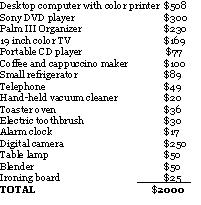Standard of Livings Keep Rising, Even for Min Wage Teens
According to W. Michael Cox, senior vice president and chief economist at the Federal Reserve Bank of Dallas, a typical college student arrives on campus today with household possessions that his parents often didn’t acquire until they were 40 or even 50 years old, reflecting the relentless rise in living standards over time.
One way to measure the significant advances in US standards of living over time is to consider what a 19-year old could buy with summer earnings at the minimum wage at different points in time.
The summer job, a rite of passage involving ten or so weeks of work between the end of high school and college, provides a useful starting point for looking at the prospects of young people entering college. Taking a job at the minimum wage of $5.15/hour in 2001, a worker could have easily pocketed $2,000 over the summer.
The earnings of one summer’s employment pack quite a lot of buying power in today's economy. The money would be enough to fill a dormitory room or small apartment with all kinds of electronics, gadgets and gizmos:

Go back to 1970, when the minimum wage was $1.60, and summer earnings at the minimum wage would have been $618, enough to only buy the following items:

What about 1950? At the minimum wage of $.75, a teenage worker would have only earned about $282 over the summer months, and his or her entire earning would have been exhausted after purchasing only 4 items, and most of the earnings would have been spent on just buying a TV:

Add it all up. When it comes to their economic prospects, today’s young Americans are the Luckiest Generation in history—at least until their children grow up and forge an even luckier one. And even if real wages are flat, the explosion of new products over time at lower and lower prices translates into a rising standard of living for all income groups, even minimum wage workers. Teenagers today can afford things like cell phones with cameras, and iPods that even a billionaire couldn't have purchased 20 years ago.

4 Comments:
Why was I able to pay my college tuition in 1972, and my kids can't do the same today?
Whitey, that is an open-loaded question. I want to ask it back to you. Why can't your kids pay for the same college education you paid for in 1972? What college did you attend, what work did you do to earn your pay to pay for your tuition, and what other resources did you have?
"...reflecting the relentless rise in living standards over time......
Add it all up. When it comes to their economic prospects, today’s young Americans are the Luckiest Generation in history—at least until their children grow up and forge an even luckier one..."
Well OK!!!! Job well done, Professor Perry. Our youth do have it going, right here, right now, in 2006. With rising standards of living, redefining "standard" seems as a logical next step...but it can't be done as standard is dictated daily by the masses, accepted by the masses, and averaged with no regard to "other" with no timetable attached. Standard is fleeting unless defined, and the dictionary's definition just doesn't offer anything concrete because it can't. No year will equal this year and no real life living realities today will equal any days or years of the past.
Since 1977, inflation for all goods and services has increased about 4% per year. Since 1977, college tuition has increased at about twice the rate of overall inflation, 8% per year. In real terms, college is tuition is 3X higher now than in 1978.
But the benefits of a college degree have probably increased by MORE than the increase in the cost of getting a college degree.
Post a Comment
<< Home